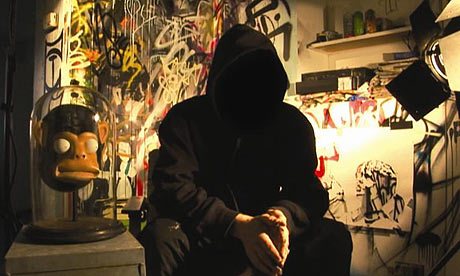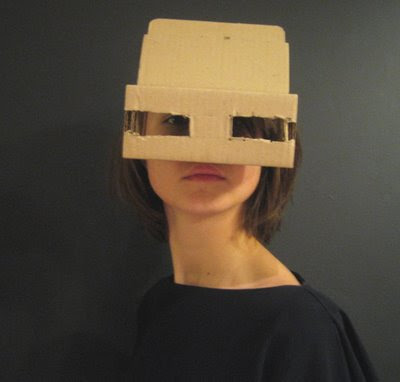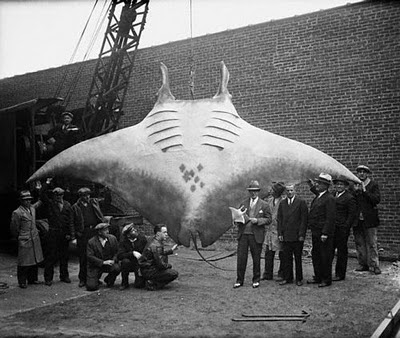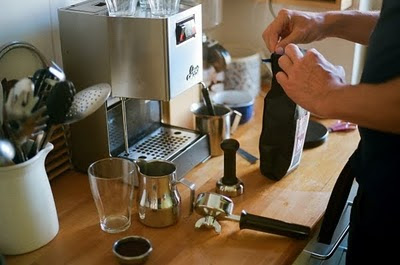Thursday, November 11, 2010
Wednesday, November 3, 2010
Tuesday, November 2, 2010
Monday, November 1, 2010
John Bell
 How does he make it look so REAL?!
How does he make it look so REAL?!
Saturday, August 21, 2010
Candy!!
 So next time, they'll be all like "Mmmmm! candy!!"
So next time, they'll be all like "Mmmmm! candy!!"Monday, August 9, 2010
Example - Kickstarts (Bar9 Remix Official Video)
Found him off youtube. eldente.
Sunday, August 8, 2010
Thursday, July 29, 2010
"Maybe it means art is a bit of a joke."

...buyers forking out $50,000 to $200,000 a canvas. “It doesn’t matter if he is good or bad,” one said. “He has the right connections, and that’s why I am buying...
Wednesday, July 28, 2010
Thursday, June 10, 2010
Pamela Love
 Human Heart necklace
Human Heart necklace Root earrings
Root earrings Birds Claw Pendant necklace
Birds Claw Pendant necklaceThe jewellery designer is the daughter of an orthopedic surgeon and granddaughter of a dentist, which shows how bizarre a child's upbringing and influences can turn out to be, on an artist's practice.
Sunday, May 30, 2010
Tuesday, May 25, 2010
Sunday, May 23, 2010
A reflection on 'The Story of Cap ''N' Trade' by Annie Leonard

Industrial designers can design products and systems that will help us reduce our carbon emissions. For example, teach people who do not already know how, to ride a bicycle. Currently, adults who do not know how, are embarrassed that they cannot. Others feel unsafe when cycling on the roads, alongside cars, buses and other vehicles, because these have not been designed to help watch out for cyclists.
The solution of putting a cap on factories and businesses on yearly carbon emissions is clever, as are the permits given out to pollute. It is like highlighting that all that they release into the atmosphere is a bad thing for the environment, and they would more likely take notice of this issue. I also like how they are charging companies their carbon pollution "points", so ultimately, they would strive towards minimal pollution. Industrial designers could design products that would help these large corporations to minimize their pollution, such as the machines that release these emissions, or reducing the number of parts in a product, hence reducing the amount of energy needed to create these parts. There needs to be a system implemented that could measure the offsets and emissions that corporations emit, so that they can be charged accordingly.
Systems and products already existing that encourage the reduction of carbon pollution in the general public sphere, would be the shared bicycle system in Europe. Now, we need more products in the industrial world to encourage the reduction of carbon polluting. The industrial sector has many opportunities to make them use less energy and emit less carbon dioxide. Products should be designed so that they use less material, and have longer life spans by being stronger and to manufacture goods that consume less energy when used. This way, we can also reduce "consumerism", in peoples constant buying compulsion.
Monday, May 17, 2010
from a to zi

This is an awesome, insightful, inspiring blog from Zi Xin Wong and Amelia - two melbournites, one is an architecture graduate and the other a photographer. I think they really like typography.
Saturday, May 15, 2010
Friday, May 14, 2010
Friday, May 7, 2010
Wednesday, May 5, 2010
NO MORE SLABS OF TEXT
Reflection on the Stamo
Jessica Tong
Some things that were unresolved were the U clamp on the vertical pole. Not enough research was done with this, and I assumed it would work, without even thinking of trying it. Probably because there was too much stuff to think about at the same time, that I missed one very important aspect of my design.
I did not think enough about the height of the room, so the issue with how long the poles were, may have been a problem. If I were to concentrate less on the afterlife of the product, I would have replaced the centre poles with ropes, just to reduce the amount of material/product needed, and figured out how to keep them from toppling. Although, then I would still need an extension of some sort to allow them to be used as vertical IV stands in hospitals after the Tsunami response.
I am happy with my posters and my model however, because I usually am unable to finish everything on time. So in that respect, I had better time management for this assignment. I learnt that we should confirm our concept earlier on in the process, and just stick with it, because if we were to constantly criticize, we would be here all day. If we stick with it, and carry it through, we are more likely to find small problems that can be dealt with later on. For example, I am usually in the ‘concept’ stage until the last week of when assignments are due, because there are so many alternatives to resolve a problem. For this, I tried to finalise my concept as early as possible. The quality of my posters, I am happy with, although maybe more detail and information about the positioning of the patients would be useful, as my ‘in context’ renderings are too vague. The balancing of the actual product has been proven and I am sure that it would not topple if produced, which is important.
I have learnt from this project that existing products that are already on the market can be utilized in my design in order to save money and materials, which I didn’t take into consideration in previous designs. In terms of model making, I am unsure why I always end up choosing the difficult way out. I should have used foam core slices stacked together, or wooden planks cut to size, sanded on the sander in the workshop and stacked together. Then primed and spray-painted from there. This would be more practical than using blue foam cutting, sanding, pollyfilla-ing, more sanding, z-poxying, more sanding, more polly-filla-ing, more sanding, more z-poxying and more sanding, then priming a few times and spraying paint. That was really painful, unnecessary, EXTREMELY costly, and just made me sick with all that blue foam in the air. But at least it turned out alright. Every assignment, I tell myself to design something compact, and simple and small to make, something easy to taken on the bus and train, but it turned out to be quite the opposite.
Monday, May 3, 2010
The Stamo






Existing problems
- Not enough drip stands at hospital.
- Overcrowded - little to no space to walk around
- Standard IV stands potentially dangerous by being knocked over in the crowded area.
- Fire departments team to patient ratio was about 10:1, but nurse to patient would have been 50:1 or worse. -- Gregory Watson from Tsunami Response Team in Banda Aceh 2004
Existing makeshift design
- Snag hazard
- Some rooms may not have exposed beams at the ceiling to hang IV drips from
My Design – The Stamo
This consists of the bases, the Euroklamp and the U-bolt hooks, which would be brought in to the disaster area, from Australia, and then supplied with standard poles from the neighboring cities in which the tsunami occurred. The local NGOs help with this.
Addressing problems through my proposed design:
- Utilises minimal material while being safe and functional
- For more patients, more poles added to extend space for IV bags
- Users can adjust how much space is given to each patient
According to Bodyspace, I would recommend a minimum of 4 people to 3 poles. Each pole being 1.2metres. Also taken into consideration is the space that the patient has to move around.
- Minimized space by allowing users to position patients head to head on the same poles
- Weight bases resistant to toppling
The Stamo
- The stand
- Basically, it is a structure that IV drips can be suspended from, to supply liquid medicine to patients on the floor
- The entire design is modular, meaning that most features can be adjusted or changed. The length of the poles are recommended to be 1.2meters, but even if a pole that is too long is used instead, the Euroklamp can be adjusted to a lower height. Also, more poles can be added on to the system, when more patients arrive.
- There are weights on either side of the frame, in the bases to prevent toppling or movement.
- If one bag is removed, or if patient’s bags sway, there will be minimal impact on other patients due to sturdy rods holding everything up.
- The parts of the entire Stamo sytem mostly consist of pre-existing products. The reason for this is because there is no use in redesigning something that already exists. Only the base which is filled with water or sand for weight and the flat piece in the U bolt was redesigned. This would save money in manufacturing and materials.
Supply the Stamo
Non-government organisations from Australia, eg. the Fire Brigade, would bring in the Stamo: the water bases, U bolt and Euroklamps. Locals would supply the poles, possibly local NGOs and bring the poles in from neighborring towns/cities. Local NGO’s in Indonesia that helped out included: Project Concern Indonesia (PCI), Mercy Corps Indonesia, Matahari Foundation (local NGO), Palang Merah Indonesia – PMI, who helped to bring equipment in.
Afterlife
In order to make full use of the product, eliminate wastage, I have designed them so that they can be used post-tsunami disaster response for hospital use. Horizontal pole is re-attached to vertical pole to act as permanent IV pole in the hospitals.
Monday, April 19, 2010
Reflection on Philippe Starck's Design for Life

The Processes / Designer's Practice:
Their whole struggle and stress and the outcome is interesting, because they are like us students in studio....we stress and stress and stress and go around in circles, with the inability to finalise an idea....which sometimes results in nothing...then there are the 'smarter workers', who work smart instead of work harder: no stress, but come up with simple, straight forward solutions. I've also been inspired by their way of researching, and how they put themselves in the target audiences shoes. We just imagine we are in their shoes, but the designers attempt to immerse themselves in the consumers, they dress themselves up silly in order, for example, to find out exactly what it feels like.
Own little world:
- In one of the episodes, someone is sent it by Starck to help the students, and help them with researching and developing their ideas. Some students, reject help, one even just stays in his own little world who whole time, believing he can pull it off. I feel that this is also being arrogant, in that they are so closed minded that they refuse to be swayed by anyone else's perspectives or input.
- Not that this observation is THAT important, but I noticed that the most arrogant students who started off were the first ones to be kicked out of the competition, in both episodes one and two.
What you need to be a designer:
Some of these professionals touch on what they believe are great designers, such as the Mac mouse, which is based off a drop of water, or a chair that has a form that is based off a leaf. It seems like they are focused so much on the appearance of the product, they forget about the usage of it, and the product in context, and how it functions. The mac mouse for example, have received many poor reviews, saying how it is not ergonomic, and creates pain in user's hands if it is used for too long.
In episode 2, it's like Starck expects so much out of them before teaching them anything, so why does he call it a school? He says he likes intelligent people but doesn't want to hire intelligent people, which makes no sense either.
Monday, March 29, 2010
Tsunami Response equipment for Indonesia
In Banda Aceh, there was a problem with corpse disposal: they were just trying to clear bodies, and place them into 3 mass graves. There was no form of identification, as there were too many bodies to handle (thousands). If people were looking for a loved one, the only way people realised they were gone was if they didn't bump into each other during the weeks after the tsunami. Even to this day, people from the 2004 Indian Ocean Tsunami, are still hoping to find their missing person.
 Bottle --> Dish
Bottle --> DishAs people were left with nothing after the tsunami, they picked out things they came across in the debris/rubble. This was unhygenic, because they picked out dishes from here to use as well. So i designed a bottle, that when peeled apart, could be used as two bowls. This would also eliminate the landfill that was left from the bottles that the NGOs were giving out, by extening the life span of the bottle, and creating another use for the product.
 IV Ground Stand
IV Ground StandThe existing IV stands were too bulky to bring from overseas into Indonesia, so they were left attaching ropes from wall to wall and hanging IV bags from there. The problem with this is that it is hard to attach rope to a wall and people kept on bumping into the ropes, so they had to cover it with coloured tape that could alert people that rope was there. It was also a very tangled network of ropes. So my design is addresing this issue by having collapsible IV stands especially designed for the patients on the ground.
Sunday, March 28, 2010
Saturday, March 27, 2010
The 11th Hour reflection

 How should industrial designers reshape their activites in order to avoid large scale ecological problems in the future and to restore the natural balance?
How should industrial designers reshape their activites in order to avoid large scale ecological problems in the future and to restore the natural balance?- Discourage the use of fossil fuel by coming up with alternative solutions
- Right now, we are not connected to the earth, in that we come up with un-natural ways to produce energy that negatively impact the environment - causing water, air and land pollution. We need to come up with ways, tha tmake use of more nautral ways of creating energy, such as solar and hydro-electric energy. In this way, we can become more connected to the earth as we should be. As industrial designers, we should use our expertise in helping to come up with ideas in promoting this, as we should look at this film, more as an enlightenment in the things that need to be achieved, as opposed to the end of the world.
- For every truckload of products = 32 truckloads of waste. Consumer goods - Aren't we as industrial designers partially responsible for that? especially when creating things that are meant to be disposed of, or already exist, or have the possibility of being redesigned to become bigger and better? --> consumerism! Maybe we can design stuff that can be added on to existing products, so that they do not have to be disposed of, just edited. "We need a waste free industrial system."
Friday, March 26, 2010
Sunday, March 21, 2010
Charette pt.2 - Underworld Class

 Blocks can be used to spell...cars can slide back and forth. another suggestion was since the material used is soft, when added to the back of the chair, it can be used as slight cushion.
Blocks can be used to spell...cars can slide back and forth. another suggestion was since the material used is soft, when added to the back of the chair, it can be used as slight cushion.  The proposed solution would improve the emotional attachment of the user to the chair by allowing the child to interact with it throughout the lifespan of the chair. Even after the toddler grows out of it, it would have sentimental value, since it helped the kid learn how to spell. Shapes made of polyeurathane foam - safe and lightweight material for toddlers.
The proposed solution would improve the emotional attachment of the user to the chair by allowing the child to interact with it throughout the lifespan of the chair. Even after the toddler grows out of it, it would have sentimental value, since it helped the kid learn how to spell. Shapes made of polyeurathane foam - safe and lightweight material for toddlers.Design Process Reflection
- Designing beyong the original product would increase the lifespan of a product, because people easily get bored of a product, or it doesnt fulfil the needs of the user as well as it used to. By adding parts to the oringinal product, usually less material would be used in comparison to buying a brand new product. In turn, shrinking the users ecofootprint.
- This collaborative problem solving activity was more interesting than designing by ourselves, because everyones different perspective and outlooks was collaborated to create something quite awesome. Also, in the real world, designers usually work in teams, so this is more applicable, and we need more getting used to team work. One person's ideas can trigger another to branch of and have more ideas.
- If i were to design a piece of furniture from scratch, I would find the problems associated with current furniture designs, in order to improve the design, and apply the 4 p's. Or maybe I would just draw and draw and draw and draw. Or if i had time, i would dig up lance's materials from last semester, and apply everything that we learnt from that class, brainstorming, peeves, product comparisons, etc etc etc.
Saturday, March 20, 2010
Charette 1 - Quick Ikea Chair exercises
 Group brainstorm on problems with constructed IKEA chair
Group brainstorm on problems with constructed IKEA chair*coming soon*
Problem Resolution 1
- swivel chair - a problem identified was that there is restricted movement and it was more for small bodies, and a particular height, so this chair has a swivel option and wheels to move around and a lever to adjust the height of the chair so kids of different height can use it.
 Problem Resoltion 2
Problem Resoltion 2- one problem was that if someone were to move houses/apartment/etc, it would be a bit troublesome to disassemble, so this design has detachable legs and back and body. Also a slightly more interesting shape.
 Problem Resoltion 3
Problem Resoltion 3- Same as mentioned above, to make travelling easier , latches are opened and closed in the corners, to collapse and construct the chair. It can be carried as one panel/piece. The fabric might be a bit more comfortable for the user's butt as well.
 Problem Resolution 4
Problem Resolution 4- detachable parts, for the back
 Physio attachment - a product that can be purchased and attached to the chair, that will improve the comfort of the chair. Some parts of the chair back are uncomfortable and it is not ergonomically sound.
Physio attachment - a product that can be purchased and attached to the chair, that will improve the comfort of the chair. Some parts of the chair back are uncomfortable and it is not ergonomically sound.Back pieces are uncomfortable, so the pieces can be removed and cushion replace it. would have string to attach to the sides of the frame of the chair.

Slide on cover, for head support

Psycho-socio attachment - a product that can be attached to the chair that will allow the user to feel some connection to the chair, for example give it sentimental value, and give it some personality that could relate to the user
Fun for the child - pieces can be bought and attached to the legs of the chairs to add colour and personality to the chair.
 For people who like fish....if they want to eat with their pets? if the user wants to watch the fish as they sit?
For people who like fish....if they want to eat with their pets? if the user wants to watch the fish as they sit?

























